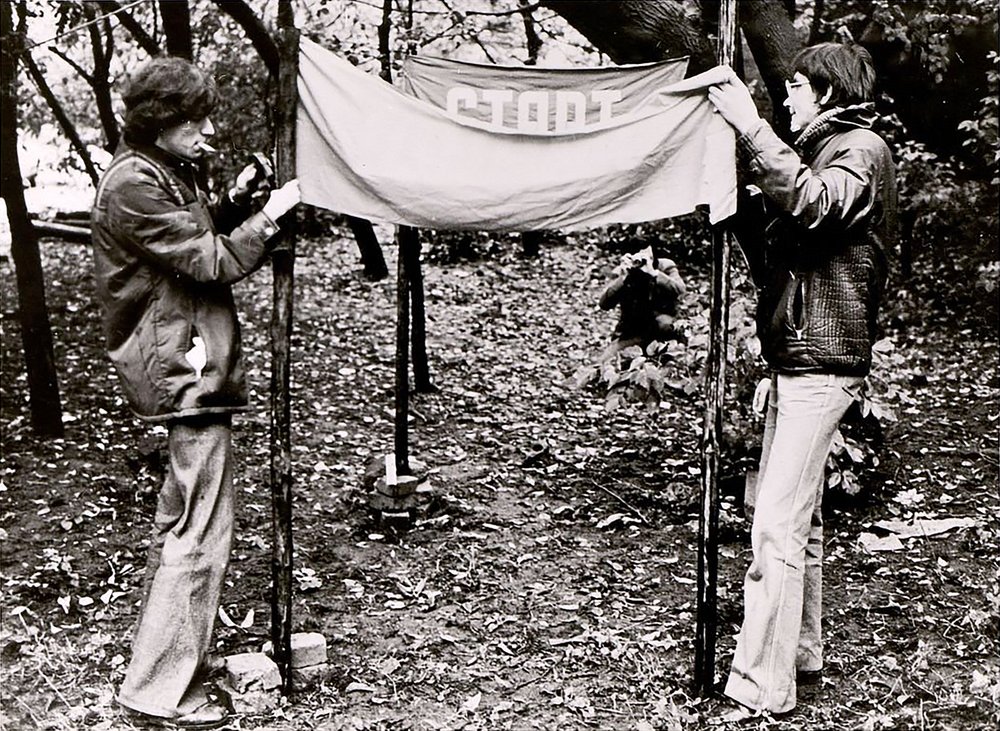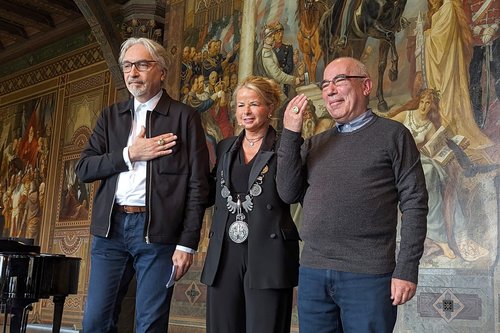Rediscovering Moscow Conceptualists: New Book by Mary A. Nicholas

Gnezdo (The Nest) group. The 'Race towards Jerusalem' action, 1978. Courtesy of Russian Art Archive
Sotheby’s 1988 auction in Moscow disrupted the lives of unofficial artists, challenging their creative identity and reshaping the art scene. Mary A. Nicholas’ new book ‘Moscow Conceptualists, 1975–1985: Words, Deeds, Legacies’ delves into this turmoil, focusing on Moscow Conceptualists, particularly the Nest collective, who navigated artistic resistance and evolving ideologies. Art critic and curator Alistair Hicks reviews this much-needed book.
On July 7th, 1988, Sotheby’s held their first auction in Moscow at the Mezhdunarodnaya Hotel. In his entertaining book ‘The Irony Tower’, Andrew Solomon describes how the lives of several unofficial artists were turned upside down. The auction house had built up a holiday spirit for the international buyers they had jetted in, but the artists under the hammer were herded in the back as if sheep in pens about to be sorted. The internal hierarchy that had kept the group of unofficial artists ‘manfully’ creating art for decades in a financial vacuum was overturned. Sotheby’s verdict on these artists did not prove to be a lasting result, but it managed to cause a good deal of misery and confusion, as well as some unexpected elation.
Mary A. Nicholas’ book is essentially trying to do what Sotheby’s failed to do. She takes the jostling, bustling, argumentative bunch of Moscow Conceptualists and tries to sort them into pens. Rather her than me! After all, in the 1980s Vadim Zakharov (b. 1959) paid his fellow artists one ruble to box their own noses. But it is a much-needed important task, and she goes about it in an academic way to which the auctioneer Simon de Pury could never have risen.
Ilya Kabakov (1933–2023), and to an extent Erik Bulatov (b. 1933), have won a significant position on the world’s art stage, but Nicholas rightly complains that this does not do justice to Moscow Conceptualism, one of the most important art movements of the late 20th century. As she laments, ‘until now, most critical attention to the conceptual movement in the Soviet Union and Russia has focused on an early generation of artists, most born at the end of the 1930s and in the 1940s, whose varied contributions have come to represent Moscow conceptualism as whole.’
Nicholas successfully shines attention on the second generation of Moscow conceptualists. Her focus lands on ´The Nest´, the artist collective made up of Gennady Donskoy (b. 1956), Mikhail Roshal (1956–2007) and Victor Skersis (b. 1956). She builds the story about the birth of resistance to the first generation of Conceptualists around the moment of the three artists sitting in a nest Hatching the Spirit in 1975. She brings this collective alive. The book is most successful as a record of The Nest from 1975 until it was disbanded in 1979. The narrative is then taken on through the partnership of Skersis and Vadim Zakharov.
Nicholas chooses very good guides to help us through the labyrinth of relationships between the various vying groups and ideas among the unofficial artists between 1975 and 1985. The strongest voices to come through are those of Yuri Albert (b. 1959) and Nikita Alexeev (1953–2021). Sadly, though she records many of Albert’s works, the magic of his and Alexeev’s work, eludes her descriptions. But then I sound ungrateful, for she has put down on paper the essential bare bones of a vital time in Russian and global history. She concentrates on the Russian story in a Soviet setting at the expense of what the work has contributed to world art history. This leads her to fixate on logocentricity of Soviet culture, as though it were not a global problem. For many years Boris Groys has been the voice of Moscow conceptualism and Nicholas rightly refuses to take on his reading wholesale, but maybe in the process she has lost his understanding of the importance of the balance between text and image. One of Moscow Conceptualism’s main contributions has been a new way of seeing art, not as being explained by text, but by the image being in a relationship with it.
Nicholas’ new book favours analytical conceptualism over others. She quotes Nikita Alexeev admitting there was a ‘camp of Kabakov and the camp of Komar and Melamid,’ before going on to criticize Groys for papering over the cracks.
‘This focus on unity has the unfortunate effect of erasing divisions,’ she writes. The book could have been sub-titled the School of Komar and Melamid. There were, of course, those like Alexeev, and to a certain extent Albert, who straddled both.
Nicholas cleverly lets works by Albert and Vadim Zacharov frame the group she is writing about. After touring his friends and contemporaries’ studios, Skersis estimated that ‘the entire avant-garde environment of the city of Moscow was comprised of thirty people.’ She explains how ‘Zacharov and Skersis set out to expand the group …[which] involved the invented artists “Katia Schnitser” and “Lena Velodina”, for example, whose work ‘All Men are Scum’ was meant to provide the unofficial Moscow art scene with feminist voices.’ Albert and Alexeev, and of course Collective Actions, created co-authored pieces with groups larger than thirty. In ‘Accepting as Gifts’, 1980, Albert wrote to a wide group of artists telling them what works he is happy to receive as gifts. ‘Household Help’ 1979–81 was rather more generous in that he offered to much the same group to do their household chores, so that the other artists could get on with their work. Ilya Kabakov did not reply but Galina Ustvolskaya, his wife at that time, did thanking Albert for his ‘selfless offer’ and effectively apologizing for her husband’s lack of response with the words ‘I.I. Kabakov does not believe in the existence of housework.’ She signed herself ‘Wife of I.I. Kabakov.’
Nicholas does make some attempts to connect this second generation of Moscow Conceptualists to what was happening in the rest of the world. She records not only Nadezhda Stolpovskaya’s (b. 1959) work as an artist but also her translations of documents relating to the work of the likes of Terry Smith (b. 1956), Robert Morris (b. 1965), Dan Graham (1942–2022), Richard Serra (1938–2024) and Lucy Lippard (b. 1937). She links Moscow to Art & Language’s ‘Modernism’s nervous breakdown.’ But this book will not be remembered for her ceaseless attempts to divide the artists into modernist and post-modernist pens, but rather for shining the light on the Nest and the artists that flourished around them. There may not be any direct links between the Nest’s desire to break down borders and barriers and the work of the likes of Francis Alys (b. 1959), but they were ahead of their time. In ‘The Communication Tube’, 1974, they emphasize the extraordinarily awkward but vital act of passing on ideas and feelings.
They were pioneers in pointing out that politicians are doing everything to avoid the main battle of our times. She quotes Skersis talking of the Soviet Regime: ‘Everything was a battle, a battle for the harvest, a battle for Outer Space, a battle for work productivity, a battle with alcoholism, everything was a battle.’ But in the larger picture, the Nest already saw in the 70s, these battles were a distraction from the battle of all battles. In desperation they strip naked and try to inject their seed into the ground in ‘Fertilization of the Earth’, 1976. Then in 1978 their despair is growing so they hold their nose in ‘A World Minute without Breathing: In Defence of the Environment’, 1978. Of course, 5-minute or even 5-year plans were never going to win our battle. As their teacher Vitaly Komar (b. 1943) advocated the official lip service to work together was never enough: nothing is good enough until we realize ‘it is simply not possible to work outside of a partnership.’
Moscow Conceptualists, 1975-1985: Words, Deeds, Legacies by Mary A Nicholas
Bloomsbury Visual Arts, 2024
London, UK





















